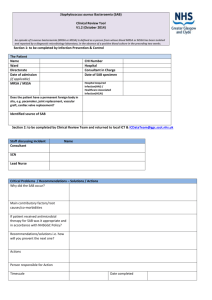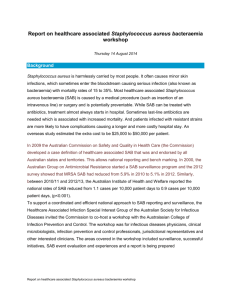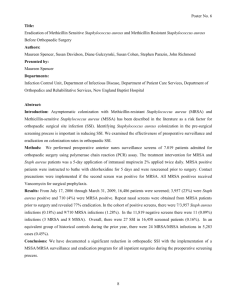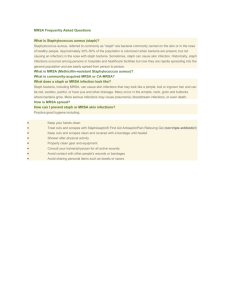CLINICAL GUIDELINE
advertisement
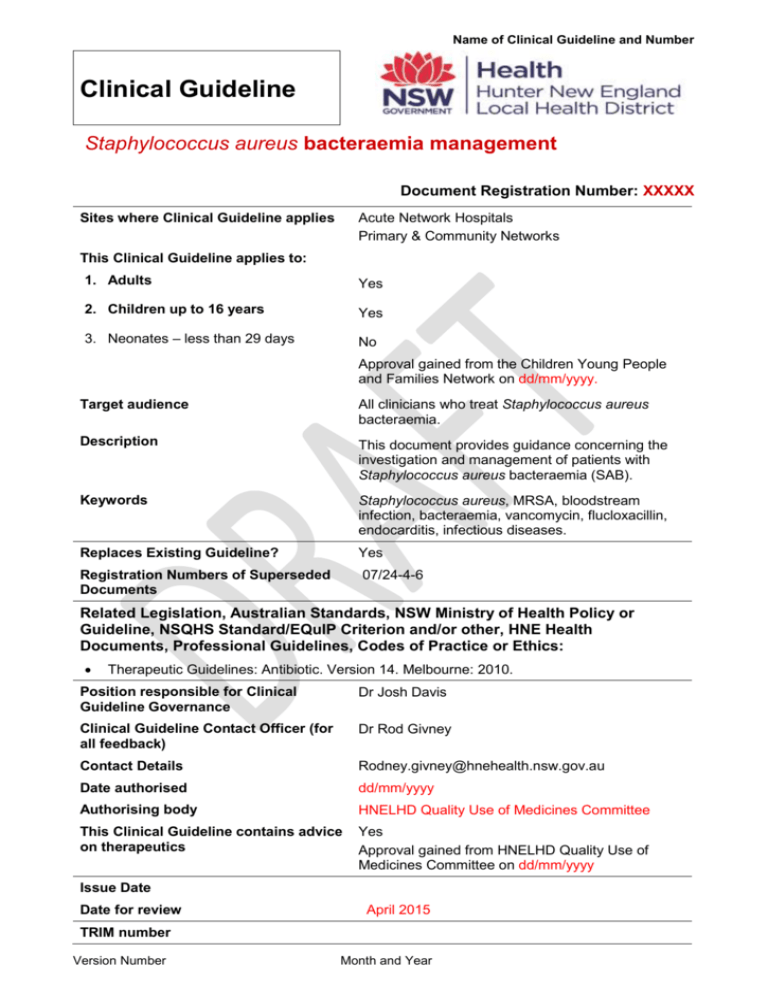
Name of Clinical Guideline and Number Clinical Guideline Staphylococcus aureus bacteraemia management Document Registration Number: XXXXX Sites where Clinical Guideline applies Acute Network Hospitals Primary & Community Networks This Clinical Guideline applies to: 1. Adults Yes 2. Children up to 16 years Yes 3. Neonates – less than 29 days No Approval gained from the Children Young People and Families Network on dd/mm/yyyy. Target audience All clinicians who treat Staphylococcus aureus bacteraemia. Description This document provides guidance concerning the investigation and management of patients with Staphylococcus aureus bacteraemia (SAB). Keywords Staphylococcus aureus, MRSA, bloodstream infection, bacteraemia, vancomycin, flucloxacillin, endocarditis, infectious diseases. Replaces Existing Guideline? Yes Registration Numbers of Superseded Documents 07/24-4-6 Related Legislation, Australian Standards, NSW Ministry of Health Policy or Guideline, NSQHS Standard/EQuIP Criterion and/or other, HNE Health Documents, Professional Guidelines, Codes of Practice or Ethics: Therapeutic Guidelines: Antibiotic. Version 14. Melbourne: 2010. Position responsible for Clinical Guideline Governance Dr Josh Davis Clinical Guideline Contact Officer (for all feedback) Dr Rod Givney Contact Details Rodney.givney@hnehealth.nsw.gov.au Date authorised dd/mm/yyyy Authorising body HNELHD Quality Use of Medicines Committee This Clinical Guideline contains advice on therapeutics Yes Approval gained from HNELHD Quality Use of Medicines Committee on dd/mm/yyyy Issue Date Date for review April 2015 TRIM number Version Number Month and Year Name of Clinical Guideline and Number SUMMARY This document provides guidance concerning the investigation and management of patients with Staphylococcus aureus bacteraemia (SAB). Infectious Diseases consultation, is recommended for all patients with SAB and has been shown to result in improved clinical outcomes[1-4]. This guideline presumes a coagulase positive Staphylococcus (i.e. Staphylococcus aureus) has been identified from at least one blood culture bottle. Adherence to this Guideline will reduce mortality, morbidity and relapse of disease. Healthcareassociated SAB are subject to investigation to identify potentially preventable factors. This document establishes best practice for Hunter New England Local Health District (HNELHD). While not requiring mandatory compliance, staff must have sound reasons for not implementing standards or practices set out within the guideline. Situation More than 300 cases of Staphylococcus aureus bacteraemia are managed each year in HNELHD. 30 day mortality from SAB is up to 30%. Relapse of infection occurs in 2-10% of adult patients and may occur up to 3 months after the original bacteraemia. Relapse rates are reduced but not eliminated by appropriate treatment. Recommendations What to do if your patient has Staphylococcus aureus grown in a blood culture: 1. Commence intravenous (IV) high dose flucloxacillin AND vancomycin (unless allergies) immediately, pending susceptibilities. 2. Remove any removable foci of infection (change IV lines, drain abscesses). 3. Evaluate for complicated SAB using the criteria defined below. 4. Repeat blood cultures between 48-72 hours following the start of treatment. 5. Monitor full blood count (FBC), C-reactive protein (CRP), electrolytes and liver enzymes every 3 days for 2 weeks and then weekly for the duration of IV antibiotic treatment. 6. Arrange transthoracic echocardiogram (TTE) on day 5-7 +/- transoesophageal echocardiogram (TOE) if necessary (see below). 7. Arrange or insert a peripherally-inserted central catheter (PICC) line once blood cultures have become negative (except in renal dialysis). 8. Consult the on-call Infectious Diseases (ID) Consultant and/or contact the on-call Clinical Microbiologist for ALL patients with SAB (by phone if necessary- 49213000 for ID consultant or 49214000 for Clinical Microbiologist). 9. Give your patient 2-6 weeks of intravenous (IV) antibiotics – see details below. 10. Provide verbal & written advice to your patient and their family about the symptoms of relapse and the need for early review if problems occur. Version Number Month and Year Page 2 Name of Clinical Guideline and Number GUIDELINE 1. Definitions 1.1 Isolation of Staphylococus aureus from blood cultures should always be considered as significant until proven otherwise. The Clinical Microbiologist (phone 49214000) is available to assist in determining the significance of these isolates. From Hunter New England (HNE) data, Staphylococcus aureus is rarely a contaminant in blood cultures (identified as a contaminant in ~ 1% of adult culture positive episodes & 5-10% children). Contamination can only be assumed if the patient does not have a compatible presentation AND repeat blood cultures are negative AND the patient has not received antibiotics. 1.2 Principal sites of infection Common sites of infection that are associated with SAB include, but are not limited to, the following: Skin and soft tissue infection (eg. abscess, boil, post-operative wound infection). Bone or joint infection (spontaneous or following procedure, native or prosthetic joint). Vascular access device (eg. intravenous cannula, central venous catheter, arterial line, tunnelled central line, subcutaneous port). Intravascular infection (eg. endocarditis, mycotic aneurysm, infected stent). Prosthetic device related (eg. pacemaker, defibrillator,joint prosthesis). Pneumonia (community or healthcare-associated). Primary blood stream infection with no apparent primary source or clear focus. 1.3 Complicated SAB Complicated SAB is defined as the presence of ANY of the following features [5]: Persistent bacteraemia at 48-72 hours following initiation of appropriate antibiotics. Persistent fever for >72 hours following initiation of appropriate antibiotics. Bacteraemia where no removable focus of infection is identified (“removable” foci include intravascular lines, drained skin and soft tissue abscesses and simple skin lesions). Metastatic focus (e.g. endocarditis, vertebral osteomyelitis, visceral abscesses). Intravascular prosthetic material (e.g. prosthetic cardiac valve, pacing wires, pacemaker, implanted defibrillator, prosthetic fistula). Version Number Month and Year Page 3 Name of Clinical Guideline and Number 2. Evaluation 2.1 Suggested assessment by the treating team All patients should have a thorough evaluation to identify the likely source and assess for complications of SAB. Initial history: Recent inoculating injury, surgery, peripheral lines or prosthetic devices; comorbidities such as immunosuppression (see below section 3.3, page 7), diabetes. History of boils or soft tissue infection. Renal dialysis treatment (see below section 4, page 8). Previous history of MRSA – check laboratory data and patient alert section on the Clinical Applications Portal (CAP) http://cap/concerto/Login.htm. Initial examination: Assess for metastatic foci, prosthetic material and evidence of endocarditis NB. Prosthetic joints commonly become seeded during SAB [13]. Ongoing assessment: Daily clinical assessment for metastatic foci (including for peripheral signs of endocarditis, cardiac auscultation for new murmurs, vertebral percussion tenderness, abdominal palpation and examination of large joints/long bones) Repeat blood cultures between 48-72 hours after initiation of appropriate antibioticsNB. Persistent positive blood cultures on treatment should prompt further discussion with ID or Clinical Microbiology service. Imaging (if clinically indicated) for deep seated abscess or osteoarticular infection. Routine imaging in the absence of localising symptoms or signs is not required. Echocardiography [6]: all patients require transthoracic echocardiography (TTE). The sensitivity of echocardiography for endocarditis is maximal at 5-7 days after onset of bacteraemia [7,8]. Initial investigation should be TTE, however transoesophageal echocardiography (TOE) should be performed in patients in the presence of a: o high clinical suspicion of endocarditis but a negative TTE. o complicated SAB with a negative TTE. o prosthetic cardiac valve. Intravascular devices: Patients with pre-existing intravascular devices should have these removed regardless of whether there are signs of infection, as retention of such devices is a strong predictor of treatment failure [14,15]. In instances where this is difficult (e.g. pacemaker/defibrillator or difficult vascular access issues), Infectious Diseases advice should be sought. Monitoring: Monitor full blood count (FBC), C-reactive protein (CRP), electrolytes and liver enzymes every 3 days for 2 weeks from the beginning of treatment and thence weekly for the duration of IV antibiotic treatment. These tests should also be repeated 1-2 weeks following the end of intravenous antibiotic treatment. 2.2 Infectious Diseases consultation (all patients) At John Hunter Hospital, where there is an on-site infectious diseases clinical service, the Infectious Diseases registrar (page 5630) should be contacted. [1-4]. At Calvary Mater Newcastle Hospital an Infectious Diseases physician should be consulted. At other HNE Local Health District (LHD) hospitals, all SAB patients should be discussed by telephone with the on-call Infectious Diseases Physician (phone 49213000) or the on-call Clinical Microbiologist (Pathology North: phone 49214000). Recommendations arising out of the consultation with Infectious Diseases or contact with Clinical Microbiology will be placed either on a Consult document associated with the Version Number Month and Year Page 4 Name of Clinical Guideline and Number patient’s record within CAP http://cap/concerto/Login.htm or in the specimen notes in the laboratory data base. 2.3 Cardiology consultation (selected patients) Early cardiology consultation/discussion (Cardiologist or suitably experienced General Physician) should occur when any question of endocarditis arises. Do not assume that consultation has happened just because the patient has had an echocardiogram (transthoracic or transoesophageal). Cardiothoracic surgical consultation is required in all patients when a diagnosis of endocarditis has been confirmed. 3. Antibiotic management All patients require immediate treatment of SAB1. 3.1 Empirical therapy For suspected (i.e. initial blood culture Gram stain showing Gram positive cocci in clusters) or proven SAB, prior to the availability of antimicrobial susceptibility results, patients should receive an appropriate β-lactam AND vancomycin to cover both methicillin-sensitive and methicillinresistant Staphylococcus aureus (MSSA and MRSA). Rates of MRSA among SAB range from 030% across different HNELHD locations2. Use: Flucloxacillin 2g (child: 50mg/kg up to 2g) IV, 6-hourly PLUS Vancomycin 1.5g (child less than 12 years: 30mg/kg up to 1.5g) IV, 12-hourly. Notes: ALL penicillin AND cephalosporin class antibiotics are contraindicated in patients with history of drug rash with eosinophilia and systemic symptoms, Stevens-Johnson syndrome or documented past immediate allergy (anaphylaxis or angioedema). Treatment should be with vancomycin alone. Where there is a history of non-immediate β-lactam allergy (eg. rash) then replace flucloxacillin with cefazolin 2g (child less than 12 years 50mg/kg up to 2g) IV, 8 hourly. Lower the initial vancomycin dose to 25mg/kg up to 1g IV for patients with an estimated creatinine clearance of < 90mLs/min. The vancomycin dose, dosing interval and timing of concentration measurement also changes in renal failure -see Therapeutic Guidelines: Antibiotic. Version 14. Melbourne: 2010, appendix 3. Vancomycin should be infused slowly, at a rate not exceeding 10mg/minute. 1 High dose IV therapy is the mainstay in order to reduce the risk of relapse from subclinical endocarditis or a subclinical deep bony source (eg. spinal osteomyelitis/discitis). 2 See http://intranet.hne.health.nsw.gov.au/hne_infection_prevention__and__control/infection_prevention_and_con trol_infection_outcomes_clinical_indicators for current data. Version Number Month and Year Page 5 Name of Clinical Guideline and Number 3.2 Directed therapy once susceptibilities known NB. For haemodialysis patients, see section 4 below. Penicillin susceptible Staphylococcus aureus (PSSA), use: Benzylpenicillin 1.8g (child: 45mg/kg up to 1.8g) IV, 4-hourly. Methicillin-susceptible (but penicillin resistant) Staphylococcus aureus (MSSA), use: Flucloxacillin 2g (child: 50 mg/kg up to 2g IV, 6-hourly. Notes: ALL penicillin AND cephalosporin class antibiotics are contraindicated in patients with history of drug rash with eosinophilia and systemic symptoms, Stevens-Johnson syndrome or documented past immediate allergy (anaphylaxis or angioedema). Treatment should be with vancomycin alone (see below). Where there is a history of non-immediate β-lactam allergy (e.g. rash) then replace flucloxacillin with cefazolin 2g (child less than 12 years 50mg/kg up to 2g) 8 hourly IV. In the absence of a contraindication, vancomycin should not be used for MSSA as it has been associated with inferior outcomes compared to beta-lactams [9]. Methicillin-resistant Staphylococcus aureus (MRSA), use: Vancomycin 1.5g (child less than 12 years: 30mg/kg up to 1.5g) IV, 12-hrly Notes: The vancomycin dose, dosing interval and timing of concentration measurement also changes in renal failure -see Therapeutic Guidelines: Antibiotic. Version 14. Melbourne: 2010, appendix3. Vancomycin should be infused slowly, at a rate not exceeding 10mg/minute. Target vancomycin trough levels are 12-18 mg/L and should be checked with a trough sample taken immediately before the fourth dose is administered. The time that the 3rd dose was given & the time that the sample was collected should be noted on the request form. A trough vancomycin level should be repeated weekly whilst the dose remains stable, AND immediately before the fourth dose following any change of dose. All MRSA blood stream isolates should have their vancomycin minimum inhibitory concentration (MIC) determined by Etest ® as an MIC >=2, correlates with poorer outcomes and all such patients should be discussed with an ID consultant or Clinical Microbiologist. In those with a vancomycin MIC of >=2, duration of vancomycin therapy should be at least 4 weeks. 3.3 Duration of antibiotic therapy Standard therapy for SAB is 4 weeks of intravenous antibiotics. This long course is justified by high mortality rates (20-30%), the presence of endocarditis in 3060% of all SAB patients at autopsy, and high relapse rates with shorter durations of IV antibiotics. A “short course therapy” of 2 weeks IV therapy (14 days) is adequate if ALL of the following four criteria are met [10-12]: 1. The patient has NO features of complicated SAB (See 1.3 above) 2. Normal valvular morphology and no evidence of regurgitant valvular lesions or vegetations on TTE (with good image quality) OR a TOE showing no evidence of endocarditis. 3. Any removable focus has been removed or drained (e.g. IV line, abscess) 4. Absence of significant immunosuppression – this includes iatrogenic immunosuppression3, functional immunosuppression due to decompensated cirrhosis (Child’s B or C), renal 3 Iatrogenic immunosuppression is defined as any of the following medications within the past 30 days: i) Prednisolone >0.5 mg/kg/day for >14 days or the equivalent ii) Cancer chemotherapy iii) Immunosuppressive Version Number Month and Year Page 6 Name of Clinical Guideline and Number dialysis (see below), HIV infection (CD4<400), congenital immunodeficiency and severe malnutrition. For all other patients, an extended course of 4 weeks or longer will be required, and a treatment plan should be discussed with the Infectious Diseases service and documented in the clinical record. 4. Adult haemodialysis patients Haemodialysis patients have a higher rate of relapse of SAB than others (see Appendix 1 for local data). They require different dosing of antibiotics due to renal impairment, as detailed below. There is no additional requirement for vascular access in these patients, as antibiotics are given at the time of dialysis. 4.1 Empirical therapy, use: Cephazolin: 2g IV post-dialysis PLUS Vancomycin: loading dose of 25mg/kg, up to 2g IV. Notes: ALL penicillin AND cephalosporin class antibiotics are contraindicated in patients with history of drug rash with eosinophilia and systemic symptoms, Stevens-Johnson syndrome or documented past immediate allergy (anaphylaxis or angioedema). Treatment should be with vancomycin alone. Vancomycin should be infused slowly, at a rate not exceeding 10mg/minute Levels should be done immediately prior to the next dialysis session in order to guide further dosing, which should be calculated according to the following table. Draw blood for vancomycin level as soon as the patient’s vascular access is cannulated, and send to pathology for an urgent request. The vancomycin dose can then be given over the last 1 hour of dialysis or ideally for an hour following haemodialysis if possible. Vancomycin level (mg/L)4 Next vancomycin dose <5 2000 mg 5 -15 1500 mg 16 – 20 1000 mg agents for solid organ transplant or autoimmune inflammatory disease iv) Biological immunosuppressive agents. 4 Achieving adequate vancomycin levels in haemodialysis patients is difficult with traditional approaches such as weekly dosing, with studies suggesting only 15-40% of levels are within the therapeutic range with this approach [16]. This table above was developed at Royal Darwin Hospital, and has been shown to achieve target levels in 84% of patients (unpublished data- Dr Davis, personal communication). Version Number Month and Year Page 7 Name of Clinical Guideline and Number 21 -25 500 mg > 25 0 4.2 For directed therapy, once susceptibilities known: Methicillin-susceptible Staphylococcus aureus (MSSA), use: Cefazolin 2g IV post dialysis (whether 2 or 3 day inter-dialysis period) [9,17,18]. Unless there is major beta-lactam allergy (below), vancomycin should not be used for MSSA as it has been associated with inferior outcomes compared to beta-lactams [9]. Methicillin-resistant Staphylococcus aureus (MRSA), use: Vancomycin 25mg/kg, up to 2g IV See above for administration and monitoring instructions. ALL penicillin AND cephalosporin class antibiotics are contraindicated in patients with history of drug rash with eosinophilia and systemic symptoms, Stevens-Johnson syndrome or documented past immediate allergy (anaphylaxis or angioedema). Treatment should be with vancomycin alone. Dosing of vancomycin in patients receiving continuous renal replacement therapy in the intensive care unit (ICU) is complex. Seek advice from an ID physician and/or the ICU pharmacist. 5. Outpatient intravenous (IV) therapy Consenting patients with SAB may be appropriate for management through an outpatient IV service. These patients must meet the following criteria: Resolution of signs of infection (e.g. fever, tachycardia, hypotension) and been clinically stable for > 48 hours. Review by the Infectious Diseases or outpatient intravenous therapy service (phone or face-to-face consult). Have a functioning PICC line or other long-term vascular access device. Come from a stable home situation with support person and access to a telephone and transport. 6. Patient information All patients with SAB require education about the risk of relapse and the need for early medical attention for possible symptoms of relapse (see Patient Information Sheet, appendix 2 below). Each patient should receive medical review one month after completion of treatment. SUPPORTING DOCUMENTS 1. For current SAB data (healthcare-associated and community events) together with proportion of events due to MRSA, see: http://intranet.hne.health.nsw.gov.au/hne_infection_prevention__and__control/infection_prevention _and_control_infection_outcomes_clinical_indicators . 2. HNELHD Fact sheet: Prevention of healthcare-associated Staphylococcus aureus infection, December 2011. Version Number Month and Year Page 8 Name of Clinical Guideline and Number http://intranet.hne.health.nsw.gov.au/__data/assets/pdf_file/0010/89479/Prevention_of_HCA_SAB _Fact_Sheet_Dec_2011.pdf Version Number Month and Year Page 9 Name of Clinical Guideline and Number IMPLEMENTATION PLAN Clinical microbiology will phone the treating doctor immediately when a blood culture signals positive with presumptive Staphylococcus & advise the doctor to follow the recommendations 1-10 from the summary in this document. The guideline summary will also be appended to the initial SAB record on the laboratory database. Recommendations arising out Infectious Diseases consultation /or Clinical Microbiology contact are placed either on a Consult document associated with the patient’s record within the CAP system or in the specimen notes in the laboratory database. These recommendations are also conveyed directly to the medical staff caring for the patient. Each healthcare-associated SAB event is investigated by the HNELHD Infection Prevention and Control Unit (IPCU) to identify preventable factors that may have been neglected. A letter concerning the investigation is sent back to the AMO for comment/information. Healthcare-associated SAB are reported on to the Incident Information Management System (IIMS) at a minimum Severity Assessment Code (SAC) level of 2. Events associated with mortality within 30 days are escalated by IPCU for consideration by the District Patient Safety Officer as to whether a formal SAC1 Root Cause Analysis process is required. SAB events where there has been a delayed diagnosis – e.g. blood cultures not collected until > 48 hours after admission in a patient who was septic upon admission are also subject to IIMS reporting and investigation. IIMS SAC2 events are subject to a London Protocol investigation utilising an agreed District template. The IIMS SAC rating for SAB events must not be reduced below level 2. Educational presentations regarding SAB and this updated guideline will be given by HNELHD Infectious Diseases /Microbiology specialists/registrars in various fora, including medical grand rounds, surgical grand rounds and specific unit meetings including nephrology. EVALUATION PLAN Clinical Microbiology will audit the collection of repeat blood cultures every 3 months. The guideline will be reviewed following consultation with key stakeholders every 2 years. Relapse and mortality rates due to SAB will be evaluated regularly. CONSULTATION WITH KEY STAKEHOLDERS 1. Medical staff across HNELHD 2. Children Young People and Families Network 3. HNELHD Pharmacy Service 4. District Antimicrobial Working Party 5. Clinical Governance Unit, HNELHD Version Number Month and Year Page 10 Name of Clinical Guideline and Number GLOSSARY Acronym or Term Definition AMO Attending medical officer CAP Clinical Applications Portal (HNELHD patient electronic medical record system) http://cap/concerto/Login.htm CRP C-reactive protein FBC Full blood count ICU Intensive care unit IIMS Incident Information Management System ID Infectious Diseases IV Intravenous MIC Minimum inhibitory concentration MRSA Methicillin-resistant Staphylococcus aureus MSSA Methicillin-susceptible Staphylococcus aureus O&A Out & About (name of the hospital in the home service based at the John Hunter/ Royal Newcastle campus). PICC Peripherally inserted central (venous) catheter PSSA Penicillin-susceptible Staphylococcus aureus SAB Staphylococcus aureus bacteraemia SAC Severity Assessment Code TOE Transoesophageal echocardiogram TTE Transthoracic echocardiogram Version Number Month and Year Page 11 Name of Clinical Guideline and Number REFERENCES 1. Choi SH, Cho SY, Park JH, Chung JW (2011) Impact of infectious-disease specialist consultations on outcomes of Staphylococcus aureus bacteremia in a hospital with a low volume of patients with S. aureus bacteremia. J Infect 62: 181-185. 2. Fowler VG, Jr., Sanders LL, Sexton DJ, Kong L, Marr KA, et al. (1998) Outcome of Staphylococcus aureus bacteremia according to compliance with recommendations of infectious diseases specialists: experience with 244 patients. Clin Infect Dis 27: 478-486. 3. Honda H, Krauss MJ, Jones JC, Olsen MA, Warren DK (2010) The value of infectious diseases consultation in Staphylococcus aureus bacteremia. Am J Med 123: 631-637. 4. Jenkins TC, Price CS, Sabel AL, Mehler PS, Burman WJ (2008) Impact of routine infectious diseases service consultation on the evaluation, management, and outcomes of Staphylococcus aureus bacteremia. Clin Infect Dis 46: 1000-1008. 5. Fowler VG, Jr., Olsen MK, Corey GR, Woods CW, Cabell CH, et al. (2003) Clinical identifiers of complicated Staphylococcus aureus bacteremia. Arch Intern Med 163: 2066-2072. 6. Fowler VG, Jr., Li J, Corey GR, Boley J, Marr KA, et al. (1997) Role of echocardiography in evaluation of patients with Staphylococcus aureus bacteremia: experience in 103 patients. J Am Coll Cardiol 30: 10721078. 7. Rosen AB, Fowler VG, Jr., Corey GR, Downs SM, Biddle AK, et al. (1999) Cost-effectiveness of transesophageal echocardiography to determine the duration of therapy for intravascular catheter-associated Staphylococcus aureus bacteremia. Ann Intern Med 130: 810-820. 8. Sochowski RA, Chan KL (1993) Implication of negative results on a monoplane transesophageal echocardiographic study in patients with suspected infective endocarditis. J Am Coll Cardiol 21: 216-221. 9. Stryjewski ME, Szczech LA, Benjamin DK, Jr., Inrig JK, Kanafani ZA, et al. (2007) Use of vancomycin or first-generation cephalosporins for the treatment of hemodialysis-dependent patients with methicillinsusceptible Staphylococcus aureus bacteremia. Clinical infectious diseases : an official publication of the Infectious Diseases Society of America 44: 190-196. 10. Fowler VG, Jr., Olsen MK, Corey GR, Woods CW, Cabell CH, et al. (2003) Clinical identifiers of complicated Staphylococcus aureus bacteremia. Archives of internal medicine 163: 2066-2072. 11. Corey GR (2009) Staphylococcus aureus bloodstream infections: definitions and treatment. Clinical infectious diseases : an official publication of the Infectious Diseases Society of America 48 Suppl 4: S254259. 12. Jernigan JA, Farr BM (1993) Short-course therapy of catheter-related Staphylococcus aureus bacteremia: a meta-analysis. Ann Intern Med 119: 304-311. 13. Sendi P, Banderet F, Graber P, Zimmerli W (2011) Periprosthetic joint infection following Staphylococcus aureus bacteremia. The Journal of infection. 14. Marr KA, Sexton DJ, Conlon PJ, Corey GR, Schwab SJ, et al. (1997) Catheter-related bacteremia and outcome of attempted catheter salvage in patients undergoing hemodialysis. Annals of internal medicine 127: 275-280. 15. Poole CV, Carlton D, Bimbo L, Allon M (2004) Treatment of catheter-related bacteraemia with an antibiotic lock protocol: effect of bacterial pathogen. Nephrology, dialysis, transplantation : official publication of the European Dialysis and Transplant Association - European Renal Association 19: 1237-1244. 16. Vandecasteele SJ, De Vriese AS (2011) Vancomycin dosing in patients on intermittent hemodialysis. Semin Dial 24: 50-55. 17. Renaud CJ, Lin X, Subramanian S, Fisher DA (2010) High-dose cefazolin on consecutive hemodialysis in anuric patients with Staphylococcal bacteremia. Hemodialysis international International Symposium on Home Hemodialysis. 18. Sowinski KM, Mueller BA, Grabe DW, Manley HJ, Frye RF, et al. (2001) Cefazolin dialytic clearance by high-efficiency and high-flux hemodialyzers. American journal of kidney diseases : the official journal of the National Kidney Foundation 37: 766-776. Version Number Month and Year Page 12 Name of Clinical Guideline and Number APPENDICES Appendix 1: SAB relapse analysis (2008-2013) Source: Analysis: Pathology North and Infection Prevention & Control databases Dr J Ferguson 1. Community-associated events 1.1 Adults (>=16yrs) Row Labels 2008 2009 2010 2011 2012 2013 Total MRSA 28 17 25 28 22 27 147 Relapses within 3 months5 MSSA cases MRSA cases 1.2 Children (<16yrs) Row Labels 2008 2009 2010 2011 2012 2013 Total MSSA 120 142 153 132 141 170 858 16 16 relapses 0 MRSA 4 4 2 1 2 1 14 Total 148 159 178 160 163 197 1005 % MRSA 19% 11% 14% 18% 13% 14% 15% (1.6%) (1.9%) (0%) MSSA 5 5 7 12 10 14 53 Total 9 9 9 13 12 15 67 % MRSA 44% 44% 22% 8% 17% 7% 21% No paediatric relapse identified over these years. Denominator for these calculations = total events – relapse events. Same patient repeat relapses excluded if related to the same original episode. 5 Version Number Month and Year Page 13 Name of Clinical Guideline and Number 2. Healthcare-associated (HCA) events (inpatient and non-inpatient combined) 2.1 Adult HCA events (>=16yrs) 2.1.1 Non-renal service Row Labels MRSA 2008 16 2009 20 2010 16 2011 12 2012 11 2013 7 Total 82 Relapses within 3 months MSSA cases MRSA cases 2.1.2 Renal Service Row Labels 2008 2009 2010 2011 2012 2013 Total 10 5 relapses 5 relapses MRSA 6 8 4 4 1 Total 67 80 76 87 72 75 457 % MRSA 24% 25% 21% 14% 15% 9% 18% (2.2%) (1.4%) (6.5%) MSSA 23 21 18 22 14 10 108 23 Relapses within 3 months6 MSSA cases MRSA cases 2.2 MSSA 51 60 60 75 61 68 375 9 7 relapses 2 relapses Total 29 29 22 26 15 10 131 % MRSA 21% 28% 18% 15% 7% 0% 18% (7.4%) (6.9%) (9.5%) Child HCA events (<16yrs) All clinical services (no renal service events) Row Labels 2008 2009 2010 2011 2012 2013 Total MRSA 1 1 1 3 MSSA 2 2 1 9 1 5 20 Total 3 2 2 10 1 5 23 % MRSA 33% 0% 50% 10% 0% 0% 13% One MSSA SAB relapse identified in 2013 (John Hunter neonatal intensive care unit patient). 6 Same patient repeat relapses excluded if related to the same original episode. Version Number Month and Year Page 14 Name of Clinical Guideline and Number Appendix 2 - Patient Information Sheet Staphylococcus aureus bloodstream infection (septicaemia) information card Patient’s Hospital Label You were recently diagnosed with a blood infection caused by a bacterium called Staphylococcus aureus (“Golden Staph”). This infection has been treated with intravenous antibiotics. Whilst this usually cures the infection, there is a possibility that your infection could return within 3 months following completion of treatment. You are advised to keep watch for any of the following symptoms: fever, chills, sweats or shakes headache, nausea, vomiting, light-headedness back ache or pain breathlessness chest pain If you develop any of these symptoms, then contact your General Practitioner as soon as possible or go to an emergency department. Take this card with you to any medical consultation. Also note that before any antibiotics are given to you, you will need to have a small amount of blood taken to look for any infection. If you have any questions, please discuss this with your hospital doctor prior to going home. Date of blood stream infection: _______________ Type of Staphylococcus aureus isolated (circle) Name: MRSA / MSSA Signed: Date: Contact number: Version Number Month and Year Page 15
